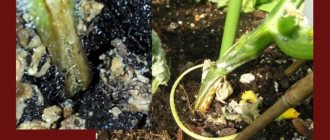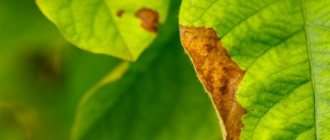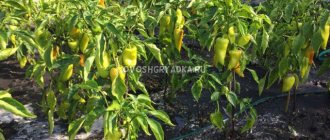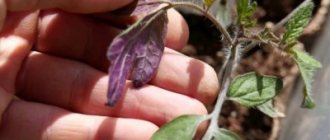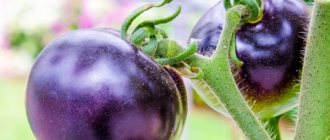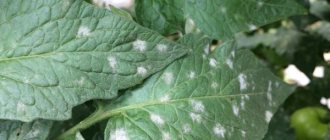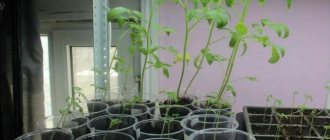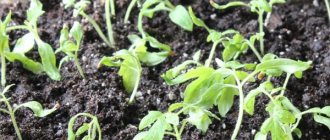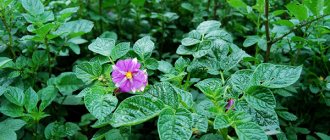Spots on tomato leaves are a good indicator of plant health. If you regularly monitor the condition of tomato leaves, you can diagnose the cause of the disease or a nutritional disorder of the bush. Early identification of a problem will help you quickly find out the causes and promptly take measures to eliminate them.
There can be several reasons for the appearance of spots on plants. As a rule, their appearance signals the onset of a disease to which tomatoes are very susceptible. Typically, various spots on tomato leaves begin to appear in the second half of summer, closer to the end of fruiting and harvest. This is quite understandable, since during this period the summer heat still lingers during the day, but the night temperature has already dropped significantly. In addition, there are fogs and cold dew in the mornings, which contributes to the occurrence of fungal diseases. Also, spots may indicate a deficiency or excess of a certain nutrient or gross errors in agricultural technology when growing tomato bushes.
So, let's look at the most common reasons for the appearance of spots on tomato leaves.
Spots on tomatoes - diagnosis
For your convenience, we have compiled a table for diagnosing problems with tomatoes by leaf color. You can immediately go to this table with photos of the most common spots on tomato leaves to make it more convenient for you to determine the cause of the problem and determine countermeasures. For a more detailed description of possible tomato diseases or other problems associated with disruption of the supply of nutrients to the tomato bush, read on.
Preventive measures
Determining the cause of yellowing tomatoes is not easy. It is much easier to follow simple measures that will keep the seedlings healthy:
- observe moderation in watering;
- maintain optimal temperature and humidity levels;
- apply fertilizers in a timely manner;
- monitor the condition of plants in order to recognize diseases in time;
- pest control;
- compensate for the lack of useful microelements;
- do not neglect preventive treatment with fungicides;
- follow the rules of crop rotation;
- regularly disinfect garden tools;
- treat the soil and seed material before planting.
Light spots on tomato leaves
If the plant has just been planted in a greenhouse or open ground in the heat, then this is a sunburn. Seedlings must be hardened off before planting. It is better to plant in the evening or in cloudy weather. You can try to help the leaves. To do this, after sunset you need to treat the leaves with anti-stress drugs: Epin, Zircon , etc. Repeat the procedure three times at intervals of a week. Usually the spots go away soon. But if the spots do not go away, you need to look for other reasons.
How to help a plant with yellowness?
If the diagnosis is successful, then measures must be taken, otherwise all the yellowing seedlings will die. For prevention, you need to perform a number of simple steps.
- Periodically loosen some of the soil before or after watering. This is done in beds with young tomatoes, planted from pots in greenhouse or greenhouse conditions.
- Plants do not like excess moisture; they need to be watered in a special way. The classic method is rare watering strictly at the root with a good volume (up to 5 liters per hole). In order not to disturb the temperature and humidity in the greenhouse or greenhouse, it is better to water in the first half of the day.
During mineral starvation, fresh tomato seedlings, on the contrary, are treated by leaves, but with a special solution. It is necessary to dilute 1% mineral salts in water and treat the yellowing leaves of the transplanted seedlings for the first few days. This approach is very useful for tomatoes and beneficial for the soil ecology.
Treating yellowed tomatoes with drugs is possible, but not advisable. Typically, gentle stimulants such as Epin are used. The drug, of course, will restore the root system and stimulate the growth of fresh leaves, but it is no longer organic.
Spider mites on a tomato leaf
White coating on tomato leaves - powdery mildew
White coating on tomato leaves, similar to spilled flour. This is powdery mildew. When powdery mildew occurs, white spots appear on both sides of the leaf. Subsequently, all the leaves fall off the affected plant, which leads to loss of yield. Low light and high humidity lead to the development of the disease. To prevent the disease, plantings should not be allowed to become dense and pruning should be carried out in a timely manner.
Powdery mildew is a very aggressive fungal disease that affects not only tomatoes, but also many other vegetables growing nearby. It spreads rapidly and can destroy all tomato plantings within a day. Diseased tomatoes must be treated with a contact-systemic fungicide. In case of severe damage, it is better to remove the diseased plants, otherwise you may lose all the plants.
It is better to remove diseased plants to avoid the spread of the disease. Treat with fungicide: Quadris, Oksikhom, Ordan, Strobi. Biological products: Fitosporin M, Baktofit, Alirin B, Gamair.
Stains left by pests
At the seedling stage, tomatoes should not have pests. It is the gardeners’ fault that they appear. Stains can be left by:
- Whitefly. This is a gnawing pest, but you can’t avoid it. Firstly, the whitefly lays eggs that look like white spots; the larvae leave yellow dots when feeding. And secondly, the insect is a carrier of sooty fungus, which causes the leaves to turn black.
- Spider mite. The first manifestation of the pest is yellow dots on the leaves of seedlings. The underside of the plate is covered with a gray coating and thin cobwebs. Appears when indoor flowers are close together or is carried by people and pets. Spreads in dry air and high temperatures.
- Aphid. A sucking pest, it leaves dots on the leaves, but it is impossible to see them under a layer of small insects. They themselves look like elongated black or red spots.
- Nightshade miner. Quarantine pest of open and protected ground. The greatest danger is posed by larvae that gnaw passages inside the leaves and leave transparent spots. It is found in the soil and on seed material, from where it gets onto tomato seedlings.
Pests need to be controlled with insecticides, preferably systemic ones. It is difficult to destroy spider mites; the preparations must have an acaricidal effect.
White spots with dark edges on tomatoes - septoria
If cloudy white spots with dark edges start from the lower leaves and then spread further, if they leave the impression of a gray coating, then most likely this is septoria - a very dangerous fungal disease. If you do not take any action, black dots will appear in the middle of the white spots, the leaves will darken and fall off. The disease can affect other leaves, stems, and fruits. The plant could become infected if the soil was poorly prepared; fungal spores could remain in it. The seed material could be contaminated, which is why the seeds need to be treated before sowing. Septoria usually develops in July because it is triggered by high humidity and intense heat.
Spots on tomato leaves and what to do? See here
Infected plants must be removed and destroyed. The disease is difficult to treat. At the initial stages of the disease, plants are treated with fungicides: Bordeaux mixture, Oksikhom, Hom, Revus. Effective biological products: Fitosporin M, Alirin.
How to treat diseases
Let's consider in turn all possible fungal, bacterial and viral diseases that affect tomato seedlings, and also figure out how to prevent the development of diseases or, if possible, cure already infected plants.
Fungal diseases
Most often, seedlings are affected by fungal diseases. They can appear from insufficiently cultivated soil or directly on plant seeds. High humidity in the room, improper watering with moisture getting on the sprouts, as well as insufficient drainage of planting containers and stagnant water contribute to the development of fungi, as they provide them with the most comfortable environment for reproduction.
Improper care of seedlings causes fungal diseases
Blackleg
This disease is very common and can appear already at the seedling stage. Otherwise it is called root rot or rhizoctonia. The fungus attacks the tomato close to the soil, causing the stem to darken and become thinner. When the fungus spreads throughout the stem, the sprout withers and falls. It is no longer possible to save this plant. The affected sprout must be removed, the soil should be shed with a 3% manganese solution, and healthy plants should be sprayed with Bordeaux mixture for prevention .
Please note that black stem in tomatoes especially often appears when the plants are not properly cared for and the environment is high in humidity.
It is impossible to save plants damaged by blackleg.
Septoria (white spot)
This fungal disease begins to affect the fruit from the lower leaves, which become covered with small light spots. Over time, the spots darken, acquiring a brown tint, and the disease itself rises higher throughout the plant.
If treatment is started in time, even heavily infected plants can be saved. Fungicides are used as medicine, for example, Ridomil Gold, Alpha Copper or Bordeaux mixture. Spraying should be repeated one and a half to two weeks before planting the plants in open ground to further protect the seedlings. As a preventive measure, you need to till the soil before sowing seedlings. This can be done using hot water (over 80 °C), 3–5% manganese solution, or specialized preparations: Aktara, Inta-Vir, Iskra.
With septoria, the white spots soon turn brown
Fusarium wilt
This fungus hides in the soil and usually attacks plant stems, which then darken, become limp and lose elasticity. After some time, the seedlings wither, starting from the upper shoots, and the leaves acquire a light shade and curl into a tube before falling off. The development of the disease can be prevented by treating the seeds and soil before planting (3% manganese solution), and only seedlings that have been in contact with the disease, but are still apparently healthy, are treated by spraying them with drugs of the class Fitocid, Trichodermin, Fitosporin-M and others.
Fusarium wilt leads to rapid death of the plant
Late blight
This fungal disease can affect not only tomatoes, but also other garden crops. It is extremely aggressive and almost always destructive to the crop. Dark spots with a light edge appear on the leaves and stems of the plant. The stems lose stability, begin to rot and dry out. You can save seedlings if you notice the damage in a timely manner. Damaged leaves and stems must be carefully removed and burned.
Never leave infected parts of plants in the garden, compost or garbage pit, so as not to contribute to the spread of the disease!
The remaining seedlings need to be treated with Bordeaux mixture using a spray bottle and carefully monitor the condition of the plants, avoiding re-infection. Before planting tomatoes in the ground, it should be treated with a 3–5% manganese solution at the rate of 3 liters per 1 square meter of area. As a preventive measure, be sure to disinfect the seeds in a similar solution before germination.
The first sign of late blight is the appearance of dark spots on the stem
Gray, white, black rot
Rots are a type of fungal disease of tomatoes and appear as spots on the stems of plants. The spots have a characteristic color with small fungal spores and spread quickly, affecting both leaves and new shoots. Prevention is carried out by disinfecting the soil before planting seeds with a solution of manganese (3%) and hot water (80 °C), as well as using purchased treated soil for seedlings. If a disease occurs, the plants affected by rot should be removed entirely, and healthy seedlings should be sprayed with Bordeaux mixture.
A characteristic sign of rot is the appearance of plaque on the root
Viral diseases
Your seedlings can become infected with these diseases through the soil, poor quality seeds, or through insects. If the virus is present in the garden bed, it will be very difficult to notice it at the initial stage, and the first manifestations will occur when the plants are already seriously infected. Therefore, you should be especially attentive to preventive procedures.
Mosaic of tomatoes
This disease is one of the most common viral diseases in tomatoes. It is transmitted to plants at the seedling stage and is manifested by a characteristic unevenness in leaf color. Light green and yellow spots appear on the surface of the leaf, gradually darkening. Over time, the leaf dries out and dies. It is impossible to save the affected plant. It should be removed from the garden bed and burned, and healthy neighbors should be sprayed with a 3% solution of manganese or urea. To prevent the disease, you should use only healthy and additionally disinfected seeds over 2 years old for sowing, and also water the seedlings twice with a 5% boric acid solution 10 and 17 days after the first shoots appear.
Yellow spots on the leaves are the first symptom of mosaic
Streak
Streak can be identified by the characteristic dark dying stripes on the stem of the plant. Later, stripes appear on the leaves of the seedlings, which eventually die and fall off. At the same time, the disease rarely destroys the entire seedling and to treat it, it is enough to remove the affected tissues, additionally treating the seedlings with a 3% manganese solution, and the soil with a similar 10% solution. Don't be afraid to damage the roots of the plant: if they have the strika virus, it will be much better to destroy it and slow down the development of the tomatoes for a few days than to leave the disease and let it affect all the plants.
Otherwise known as tomato roughness.
Aspermia
This viral disease can be identified by the weak, thin and clearly underdeveloped stem of the plant. Aspermia is also characterized by deformation and shredding of tomato leaves. This disease is spread through soil and insects, so as a method of prevention it is worth carrying out all the necessary procedures for disinfecting the soil for seedlings, as well as keeping the plants clean and at the correct humidity level. It is not possible to cure diseased sprouts. For additional protection, you can water the young seedlings once with a 5% solution of magnesium permanganate.
Aspermia is an incurable disease
Bacterial diseases
This type of disease is extremely dangerous and is transmitted to plants through contaminated soil or is present on seeds. Bacteria can be in a “dormant” state if overheating of seedlings (regularly above 26 °C) and excessively high soil moisture (including stagnation of water in planting containers) are not allowed.
Black spot
Visual signs of black spot appear quite late: for a long time, plants may look normal or be only slightly lethargic. At the final stage of the disease, the leaves and stems of tomatoes become covered with black spots. To prevent the disease, you should buy only proven healthy seeds, as well as carry out all selection, disinfection and hardening procedures. Black spotting should be treated with Bordeaux mixture, spraying the plants every 2-3 days.
This bacterial disease is most often transmitted to plants from low-quality infected seeds.
Brown spot
This tomato disease manifests itself in the form of small yellow spots on the leaves, and a white coating forms on the underside of the leaf. Over time, the leaf is completely affected and dies. As a preventative measure, you should carefully monitor the temperature conditions of the seedlings and prevent them from overheating. If the disease has already affected the tomatoes, carry out therapeutic spraying of the plants using a copper-containing preparation, for example, sulphate or copper sulfate.
Brown spot affects tomato leaves, causing them to die
Silvery spots on tomato leaves
Some gardeners are frightened by the appearance of such silvery spots on the leaves, mainly in greenhouses. This is not a disease, but a physiological disturbance in the development of the plant (anomaly). This occurs due to sharp changes in night and day temperatures, as well as due to genetic changes when seeds of poorly processed hybrids go on sale. These physiological manifestations are not dangerous, so there is no need to worry if you experience these symptoms. You can use anti-stress drugs: Epin, Zircon , etc., timely ventilation and closing of the greenhouse.
Other causes of yellow spots
| Chemical burn Appears when treated with too concentrated products. If you do not follow the proportions, or use compounds not intended for application to foliage, then burns will remain on the surface. There is no cure for this problem. If the damage is not very severe, the plant usually recovers from it and develops further normally. With severe burns, the bush may die | |
| Sunburn Appears from violation of agricultural technology: watering during the daytime. Drops of moisture on the leaves serve as a kind of lenses; after drying, it is discovered that dry spots have appeared, these are burnt plant tissues. The problem cannot be resolved. Usually the tomato develops normally if you do not continue to water it in the same way and do not cause even more damage to the foliage | |
| Spider mite damage This small pest attacks plant tissue on the underside of the leaf. It absorbs juices, which causes yellow spots to appear, and the leaves themselves curl and become deformed. The fight is carried out using suitable means. Cobweb nests in which the larvae hatch are also removed. |
The author of the video shows another reason for the appearance of yellow spots on the leaves. They appear after a hailstorm.
Green and yellow spots on tomatoes - tomato mosaic
In tomatoes affected by this disease, a characteristic mosaic pattern appears on the tops in the form of alternating green and yellow spots. In young leaves, the mosaic pattern is more clearly visible than in older leaves. The disease spreads very quickly to nearby tomato bushes. In the future, yellowish spots may appear on the fruits. This is tomato mosaic , a viral disease. The virus is transmitted by insect pests in the soil, but first of all, infection occurs with seeds. Therefore, to prevent mosaic, it is necessary to choose seeds of hybrids that are immune to this virus. If there is no data on the variety’s resistance to mosaic virus, then the planting material must be pickled in a 1% solution of potassium permanganate for 20 minutes.
Plants affected by mosaic are not treated , but are removed from the site and then destroyed.
Bronze angular spots, rings or circles
How it manifests itself:
The change in color of the leaf blade, mentioned above, is the first symptom of the disease. Subsequently, angular spots, circles or bronze-colored rings form on the leaves. Then they turn brown. Large concentric pale brown spots appear on green fruits. As the tomatoes ripen, these spots turn yellow.
Conditions for active development:
Most often, the virus affects open ground tomatoes. The infection is carried by harmful insects, namely thrips. The greater the number of pests, the more actively the disease spreads.
What to spray:
The fight against spotted wilt virus comes down to the destruction of insect vectors. Insecticides like Aktara, Confidor, etc. are used against thrips.
Yellow spots on tomato leaves - cladosporiosis
Small yellow spots, first on the lower, then on the upper leaves of tomatoes. These are the initial signs of the fungal disease cladosporiosis (brown spot, leaf mold).
Subsequently, on the back side of the leaves, the space under the spots becomes covered with a light gray coating (later becomes brown). The leaves curl and dry out.
When an infection occurs, you need to spray the plants with the following preparations: Quadris, Abiga Peak, Polychom, Tsineb. Among the biological products that are effective: Alirin, Fitosporin M, Pseudobacterin
Cladosporiosis of tomato causes great harm in greenhouses. The shortfall in fruit yield reaches 30–40%. Brown spot can be stored in greenhouses for up to ten years, so it is important to disinfect the greenhouse and soil when the disease appears.
Brown spots on tomato leaves - cladosporiosis
Brown spots on tomato leaves appear first in the lower part of the bush, then spread to the upper leaves. After some time, a dark velvety coating forms on these spots. Less commonly, flowers and fruits are infected, which turn brown and fall off if infected.
These are clear signs of the spread of the dangerous fungal disease cladosporiosis ( brown spot, leaf mold. Spots on tomato leaves and what to do? See here
Yellowing of leaves on seedlings
The leaves of young plants may begin to turn yellow due to natural reasons. Transplanting seedlings from pots to garden beds is stressful for the plants. Yellowness on the leaves indicates the adaptation of tomatoes to new conditions. This happens due to a temporary failure in the supply of nutrients from the root system to the tops. To maintain viability, the plant rejects the lower leaves.
If the problem is caused by planting stress, only the lower leaves will be affected by the color changes. After a few days, the leaves should fall off; if this does not happen, they are removed manually.
Other reasons for yellowing seedlings:
- small container;
- watering errors;
- hypothermia;
- nitrogen deficiency;
- insufficient lighting;
- soil acidification.
Black spots on tomato leaves - late blight
This is a clear sign that tomatoes are affected by late blight. This is the most dangerous and common fungal disease that occurs in both ground and greenhouse tomatoes. Develops from dampness against the background of a sharp temperature change. Black-brown spots appear on all parts of the plants: first the leaves turn black and dry out, and then black spots and necrosis appear on the fruits. The earlier the disease is detected, the greater the chances of saving the plant and avoiding the spread of the disease. If there are obvious signs of the disease, the plant cannot be cured. The main thing is to contain the spread of infection, otherwise you may lose the entire harvest.
Diseased leaves must be removed immediately upon detection. This must be done extremely carefully, as fungal spores can get on healthy plants. Plants need to be treated with chemical fungicides: Hom, Ordan, Oksikhom, Profit Gold, Revus, etc. Treatment should be done once every 7 days, the frequency of treatments is indicated in the instructions for the drug.
Biological products used: Alirin B, Gamair, Fitosporin M, Trichodermin
Brown (brown) spots of tomatoes - late blight
Brown spots appear on the lower leaves of the tomato, then throughout the plant. Unripe fruits turn brown. In cold weather, a whitish-gray coating appears along the edges of the spots on the leaves. With increased humidity, damaged leaf tissue softens. These signs also signal that the tomato bush is infected with late blight. Spots on tomato leaves and what to do? See here
Incorrect agricultural technology
Yellow spots on the leaves may also appear due to non-compliance with the rules for growing tomatoes. Usually these are the following reasons:
- high humidity;
- illiterate transplantation;
- mechanical damage to plant roots;
- lack of microelements and nutrients;
Let's take a closer look at these reasons below.
High humidity
If you grow tomatoes in rainy summers, in extremely humid conditions, or in an unventilated greenhouse with frequent watering, yellow spots on the leaves are likely to appear. Typically, the appearance of this symptom in such conditions is caused by a fungus and is treated with appropriate fungicides.
When watering, you need to make sure that drops of water do not fall on the leaves. Under the influence of sunlight, these drops will turn into a kind of lenses and lead to burns of the leaves and the appearance of spots.
Transplantation and root damage
These two reasons overlap with each other, since usually the roots are damaged during the transplanting process
To avoid this problem, when replanting it is necessary to handle the roots of the tomatoes very carefully, do not tear them off, and carefully place them in the hole
Nutritional deficiencies
If this is the reason, the tomato usually lacks zinc, copper, boron, molybdenum, sulfur or magnesium with nitrogen. To solve the problem, it is necessary to feed the plants, and in the future do not forget about the procedure for applying fertilizers.
A lack of all of these minerals causes spots of varying sizes and characteristics on tomato leaves. Let's get acquainted with the symptoms in order to know exactly which microelement the plants lack.
- Nitrogen - a lack of this mineral manifests itself as a uniform covering of all leaves with small yellowish spots.
- Copper - in this case, the bush does not become stained, but the greenery becomes noticeably paler and light green.
- Sulfur - the leaves noticeably turn yellow, becoming hard to the touch.
- Magnesium - the foliage is covered with small spots of a brownish-yellow hue.
- Manganese - yellowing of the leaves is accompanied in this case by subsequent rotting of the affected parts.
- Phosphorus - with a lack of this mineral, the top of the tomato bush turns yellow.
Sometimes yellow spots can also be caused by improper lighting of tomato bushes - often too intense, but sometimes by excessive shading.
Video on the topic:
Dark (brown) spots on tomatoes - black bacterial spot
The spots do not merge into large and dark ones, as with late blight, but rather look like a black rash. Symptoms of black bacterial spot of tomatoes.
Initially, small spots of olive color appear on the leaves, oily in appearance, only about 1-2 mm in diameter. Quite quickly they darken and spread, covering all larger parts of the leaf and stems.
All above-ground parts of the plant are affected: leaf petioles, sepals, stalks, tomatoes and peppers. As the fruits grow, spots also appear on them, their number increases, by this time the stems and leaves seem to be covered with scabs. Due to malnutrition, the fruits do not ripen, and the leaves gradually dry out and fall off. Yield losses can be 90-100% - rotting of the fruit tissue occurs under the spots. Loss of leaf mass from 50 to 100%.
Treatment with chemicals is carried out with copper-containing fungicides - spraying with a 1% solution of Bordeaux mixture, preparations Hom, Oxychom, Ordan, etc.
Among the biological preparations, the drug Fitolavin is very effective on tomatoes - it helps to treat not only bacterial black spot, but also bacterial cancer, tomato blossom end rot and other nightshade diseases
Fighting methods
What to do if spots appear on tomatoes? Since there are many problems that cause yellowing of tomato foliage, it is important to correctly identify the source of the problem and eliminate it. If the tops have turned yellow due to illness, you should not leave things to chance
Diseases are treated with chemicals and folk remedies.
Chemical and biological agents
Fungicides are effective against most tomato diseases.
The following drugs are used in treatment:
- "Abiga Peak";
- "Barrier";
- "Ordan";
- "Bravo";
- "Thanos";
- "Ditan";
- "Revus";
- "Quadris";
- "Consento";
- "Fitosporin";
- "Fundazol";
- copper sulfate;
- Bordeaux mixture.
Insecticides are used to control pests:
- "Iskra M2";
- "Confidor Extra";
- "Decis Profi".
Strengthen the root system with the help of growth stimulants:
- "Epin";
- "Heteroauxin";
- "Larixin";
- "Novosil";
- "Kornevin".
Correcting ground imbalance
As soon as it becomes clear which element is missing in the soil, it is necessary to feed it with special additives:
- Phosphorus. The deficiency is eliminated with the help of “Superphosphate” - 15 g per 10 liters of water, the dosage is designed to treat 1 square meter. m.
- Magnesium. Foliar treatments are carried out with magnesium nitrate - 5 g per 10 liters of water.
- Potassium. Use potassium sulfate - 8-10 g per 10 liters of water. Treatment is carried out once every 4-5 days; after 3 procedures, a solution of the drug should be added to the soil - 15 g per 1 square meter. m.
- Boron deficiency is corrected by spraying with a 1% boric acid solution. The procedure is carried out in the evening.
- Iron. The bushes are sprayed with a 1% solution of copper sulfate or iron chelate. These products are suitable for foliar treatments.
- Manganese. The seedlings are sprayed with a 1% solution of potassium permanganate.
- Molybdenum. Plants should be treated with a solution of ammonium molybdate - 2 g per 10 liters of water.
Traditional methods
You can restore the nitrogen balance with urea - 1 tbsp. l. drug per 10 liters of water. The dosage is calculated for 1 square. m. Foliar treatments are also effective - 1 tsp. for 10 liters of water. During the procedure, the above-ground part of the plant is sprayed.
Organic fertilizers are also used to saturate the soil with nitrogen:
- mullein - 1 liter of fertilizer per 10 liter bucket of water;
- bird droppings - 500 g per 10 liters of water;
- wood ash or soot - 250 g per 10 liters of water.
Agrotechnical techniques
If there is excess moisture, stop watering for several days. To restore balance, add urea to the soil - 1 tsp. solution per 1 sq. m.
To prevent the plants from burning, an additional awning or canopy is installed on the garden bed for several weeks after planting. As soon as the seedlings take root, the cover can be removed.
When planting seedlings, keep a distance to prevent crowding. The distance between plants should be 70 cm.
If the leaves on the tomatoes begin to turn yellow due to lack of light, they cannot be replanted. It is better to thin out the tops by removing leaves that shade each other.
Restoring the root system takes a long time
During this period, it is important to provide the plant with sufficient nutrition and watering.
You can restore the balance of beneficial microelements with the help of additional fertilizing with “nitroammophoska” - 1 tsp. drug per 10 liters of water. Treatment is carried out once every 3-4 days in the evening until the yellowing of the leaves stops.
Dark sunken spots on tomatoes - Alternaria
There are rounded dark depressed spots on the leaves, stems, and fruits. This disease manifests itself in hot weather - Alternaria (macrosporiasis). The size of the spots can reach several centimeters and they will be dry in any weather. The disease causes yellowing of the plant's leaves. A distinctive sign of its appearance is spots of black plaque on the leaves and fruits.
What to do? Treatment with fungicides: Quadris, Hom, Ordan, Profit Gold, Oksikhom, Bordeaux mixture. Treatment with biofungicides: Alirin, Fitolavin, Fitosporin M, Trichodermin
Small spots with a dark brown color - Fomoz
Numerous small dark brown to black spots appear on the leaves, which may form concentric rings as they increase in size. This is Phomaz (Phomosis rot) . In case of illness
Fruits, both unripe and ripe, are affected. Phoma can be identified by the characteristic brown spot that appears near the stalk. Then it increases in diameter, but not much. Typically the spot reaches a size of about 3 centimeters. The main spread of rot occurs inside the fruit.
The pathogenic fungus can survive in the soil, in contaminated plant debris, as well as on pepper plants and closely related weeds. The spread of the disease is facilitated by high humidity and fertilizing rich in nitrogen. Spots on tomato leaves and what to do? See here
As a preventive measure, the soil is disinfected, and it would not be a bad idea to treat the internal parts of the greenhouse with a disinfectant solution.
Treatment is carried out with the following drugs: Bordeaux mixture, Hom, Oxychom. Diseased fruits must be collected and destroyed.
Nutrient deficiencies and excesses
It is interesting that curling, yellowing, followed by drying of the foliage and falling of the fruits, is observed both with a lack and with an excess of nutrients in the soil.
- Nitrogen is the best friend and enemy of tomatoes. Excess nitrogen is expressed in curling and increased fragility of leaves on the bush. The deficiency is noticeable in the stunted, pale-colored leaves of the plant.
- Potassium is an immunity aid. With its deficiency, the leaves shrink inward, the edges are bordered with “rust”. An excess of this microelement leads to stunted growth, mosaic pigmentation of foliage, its curling and death.
- Phosphorus is especially important in the early stages of development. Phosphorus starvation leads to leaves curling on the wrong side, changing their color from green to brown-brown.
Many symptoms of deficiency or excess of microelements are very similar in appearance. In addition, with a significant deficiency or excess of one of the elements, the plant’s absorption of others is disrupted.
If visually it is not possible to correctly determine the cause of the disease, then it is better to use complex fertilizers in which nutrients are specially selected for the full development and growth of tomatoes in optimal proportions.
Fertilizers that have proven themselves well are: Ammofoska, Nitrophoska, Diammofoska, Nitroammofoska, Kristalon for tomatoes, Red Giant, Krepysh, Kemira (Universal, Lux), Mortar.
Tomato nutritional deficiency
You can read more about nutritional deficiencies in the article on our website “What tomatoes lack: nutritional deficiencies.” You can determine which microelements the plant lacks by the appearance of tomato leaves. Their color, and the general condition of the leaf . The deterioration of the condition of tomatoes is most often caused by a deficiency (less often, an excess) of micronutrients. What kind of feeding tomatoes need can be determined by the change in color and condition of the leaves of the tomato bush. Now we will consider diagnosing a deficiency or excess of nutrients only by the presence of spots on tomato leaves.
Light yellow-green spots on tomato leaves - nitrogen deficiency
Tomatoes burn at the edges, old leaves turn yellow and fall off. Plants stretch out, look stunted, leaves become smaller, acquire a light green color with a yellowish tint, and the stem becomes soft. The veins on the underside of the leaf are reddish-bluish in color.
What to do? Feed the tomatoes with nitrogen fertilizer, for example, urea (1 tablespoon per 10 liters of water). Spots on tomato leaves and what to do? See here
Yellow-brown spots - potassium deficiency
Young tomato leaves roll up inside a tube - they become curly, and old leaves turn yellow and dry out at the edges. First, the leaves darken, then yellow-brown spots appear along the edges, which gradually grow, forming a border.
What to do? Fertilizing with potassium nitrate (1 tablespoon of fertilizer per 10 liters of water) half a liter of solution per bush, spraying the leaves with a solution of potassium chloride (1 teaspoon per 1 liter of water).
Yellow with necrotic spots - Excess potassium
With an excess of potassium, the lower leaves of tomatoes turn yellow and dark necrotic spots appear on them). Excess potassium is dangerous for plant roots. High potassium content can cause burns to the root system. In addition, excess potassium leads to difficulty in the absorption of nutrients such as calcium, magnesium, zinc, boron, etc.
What to do? Stop fertilizing with potash fertilizers and ash. Spots on tomato leaves and what to do? See here
Leaves curl upward and turn yellow - magnesium deficiency
Tomato leaves curl upward and begin to turn yellow between the veins.
What to do? Foliar feeding (spraying on the leaves) with a solution of magnesium nitrate (1 teaspoon per 10 liters of water) or Epsom salt diluted in the same proportion helps well.
Pale green spots on young leaves - sulfur deficiency
Signs of sulfur deficiency are similar to nitrogen deficiency: pale green leaf color turning yellow, red-blue veins. But sulfur deficiency appears first on young leaves (with nitrogen the opposite is true). The stem of the plant also becomes thinner, it becomes brittle, brittle, and woody.
What to do? Foliar feeding with magnesium sulfate (1 gram per 1 liter of water) helps.
Purple spots - phosphorus deficiency
The leaves and stems of tomatoes darken to a dark green color with a blue tint, the lower part of old leaves acquires a purple tint. The leaves curl inward, the stem becomes stiff and brittle, and the roots wither. The tomato leaf color and stem may turn purple. At the same time, the leaves rise up and are pressed against the stem.
What to do? Feed the tomatoes with phosphorus-containing fertilizer. To prepare the fertilizer, pour 1 liter of boiling water into 1 cup of superphosphate and leave to steep for 8-12 hours. Dilute the resulting infusion in 10 liters of water and pour half a liter of fertilizer under each bush.
Possible causes of yellowing leaves
Yellowing of leaves is a common phenomenon both indoors and outdoors. Why do the stems and foliage of tomatoes turn yellow? A change in the color of the tops can be caused by errors in care, diseases or an imbalance of substances in the soil.
When yellowing appears on the leaves, do not panic - it is important to quickly and correctly identify the source of the problem
Lack of fertilizers
Lack of nutrients negatively affects the condition of plants
To correctly determine which substance is too little, you need to pay attention to which part of the plant the yellowing began
What happens when there is a deficiency of specific elements:
- Nitrogen. If there is a shortage, the tops turn yellow or discolored. Young leaves grow small, and the plant itself weakens. Lack of nitrogen also negatively affects fruits.
- Phosphorus. The appearance of yellow spots on the lower leaves is also characteristic of a lack of phosphorus. The leaves become smaller, their edges curl, and the stem takes on a purple hue.
- Potassium. The lower leaves of the seedlings turn yellow, curl and die, and the stems become stiff. Changes begin from the edges of the leaf plate, new leaves grow small and thick.
- Zinc. In addition to yellow spots, brown and gray blotches appear on the foliage. Over time, the leaves die off.
- Magnesium. The foliage color changes to yellow between the veins. New leaves curl inward, and old ones become covered with brown spots and fall off.
- Bor. The upper leaves become covered with yellow spots, the veins turn brown. The plant grows in width and sheds flowers.
- Sulfur. First, the upper leaves turn yellow, then the changes affect the lower branches. The tops become brittle and brittle.
- Iron. Yellow spots appear in the middle of the leaf blade and along the veins.
- Manganese. Yellowness appears in the middle of the leaf; near the veins, the color of the spots is heterogeneous, yellow-green.
- Molybdenum. The first pair of true leaves turn yellow and curl upward. The color change begins with the appearance of small yellowish spots, then covering the entire surface of the plate. The leaf veins remain green.
Root damage
The root system is responsible for feeding the entire plant. Its damage negatively affects the foliage.
A change in the color of the tops can be caused by a depressed state of the roots, which occurs for various reasons:
- pest damage;
- weakening due to excess vegetative mass;
- transplant injuries;
- deep loosening of the soil;
- poor quality seedlings.
Most often, yellowing of foliage is caused by a weakening of the root system, which cannot cope with the nutrition of the tops. The result is starvation and leaf death. The color change of the tops begins from the bottom of the plant.
Often the reason for insufficient development of the root system is poor-quality or improperly prepared seedlings. The plant was grown in small containers, which constrained the roots. Such plants have abundant green mass, elongated upward. After the transplant they often get sick.
Sunburn
Lighting plays an important role in seedling growth. Excessive sunlight can cause foliage to burn and turn yellow. This usually happens during a period when the plants are weakened after being planted in the garden.
The tops may also turn yellow due to lack of light. Thickening of plantings leads to the fact that plants do not receive enough light. As a result, the lower and middle leaves begin to change color and fall off.
Excess moisture
A lack of moisture, as well as its excess, negatively affects the health of tomatoes. With insufficient watering, plants begin to save moisture, trying to reduce its evaporation. In this case, the leaves are rejected.
When there is a lack of moisture, the leaves first curl, then their color changes and they fall off.
With abundant watering, the plant forms excess green mass, the nutrition of which the roots cannot cope with. This leads to insufficient development of the root system and poor absorption of nutrients from the soil. Yellowing of foliage with excess moisture occurs due to a lack of nitrogen.
Plants grown in a greenhouse or greenhouse may turn yellow due to high humidity. The optimal humidity level is 60-70%; as the indicator increases, the tops begin to rot. The situation may be aggravated by low air temperatures.
Pests
Insects can also cause tomato leaves to turn yellow and die:
- whitefly;
- aphid;
- tobacco thrips;
- Colorado beetle.
